Total Population grows at a rate of 0.61 percent annually
Based on the 2020 Census of Population and Housing (2020 CPH), the municipality of Balaoan, La Union posted a total population of 40,339 persons as of 01 May 2020. This is an increase of 1,151 persons over the total population of 39,188 persons in 2015 Census of Population (POPCEN). (Figure 1)
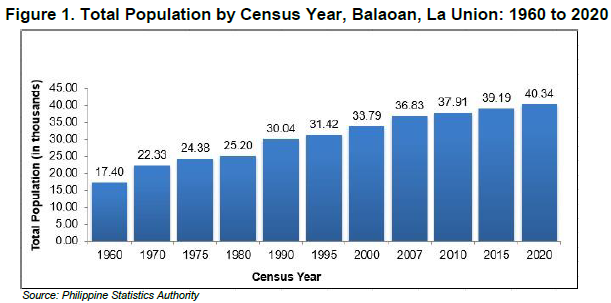
Population increases by 6 persons per year for every 1,000 persons
The increase in the population count of the municipality from 2015 to 2020 translated to an average annual population growth rate (PGR) of 0.61 percent. This means that there were about 6 persons added per year for every 1,000 persons in the population. (Figure 2)
The annual PGR was lower at 0.63 percent during the period 2010 to 2015 and at 1.16 percent during the period 2000 to 2010.
If the average annual PGR recorded at 0.61 percent during the period 2015 to 2020 continues, the population of Balaoan, La Union would double in 115 years.
Sixty years ago, the population of Balaoan, La Union was only 17,401 persons. This population size is more than two-fifth of the population of the municipality in 2020 CPH.

Barangay Paraoir (Pob) remains as the most populous in 2020
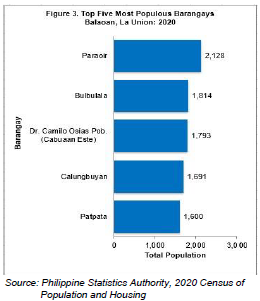
Among the 36 barangays in the municipality of Balaoan, La Union, Paraoir was the most populous with a population size making up 5.28 percent of the total municipal population. Bulbulala was second with 4.50 percent share, followed by Dr. Camilo Osias Pob. (Cabuaan Este) with 4.44 percent, Calungbuyan with 4.19 percent and Patpata Norte with 3.97 percent.
The least populated barangay was Baracbac Oeste with 1.06 percent share to the total population of the Municipality. It was also the least populated barangay in 2015.
Sex ratio increases to 103 males per 100 females
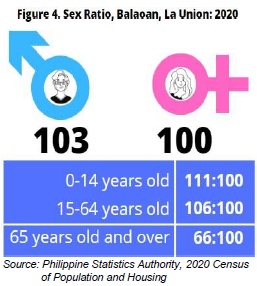
Of the 40,283 household population in 2020, males accounted for 50.81 percent while females comprised 49.19 percent. These figures resulted to a sex ratio of 103 males for every 100 females, an increase in sex ratio from 101 recorded in 2015.
In 2020, children aged below 15 years had a sex ratio of 111 males per 100 females, while those aged 15 to 64 years had a sex ratio of 106 males per 100 females. On the other hand, among those aged 65 years and over, the sex ratio was 66 males per 100 females (Figure 4)
Median age increases to 29 years
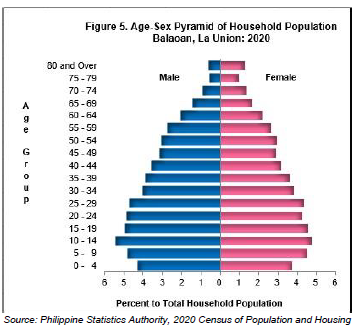
In 2020, the median age of the household population of the municipality was 29.26 years, which means that half of the population was younger than 29.26 years. This is higher than the median age of 27.77 years recorded in 2015.
Children aged 10 to 14 years (9.41%) comprised the largest age group, followed by those in the age groups 15 to 19 years (8.84%) and 5 to 9 years (8.69%). Males outnumbered females in the age groups 0 to 59 years. On the other hand, there were more females than males in the older age groups (60 years and over).
More than half of the household population are of voting age
The voting-age population (18 years and over) accounted for 69.00 percent of the household population of the municipality in 2020, up from 66.97 percent in 2015. There were more females (50.05%) than males (49.95%) among the voting-age population.
Dependency ratio decreases to 50 dependents per 100 persons in the working age group
In 2020, the young dependents (0 to 14 years) comprised 25.55 percent of the household population while the old dependents (65 years and over) posted a share 8.15 percent. The working age population (15 to 64 years) accounted for the remaining 66.30 percent.
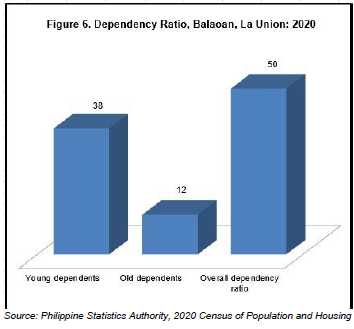
The overall dependency ratio was 50, which indicates that for every 100 working age population, there were about 50 dependents (38 young dependents and 12 old dependents). This ratio is lower than the dependency ratio in 2015, which was recorded at 54 dependents per 100 working age population.
Males dominate females among the never-married persons
Of the household population 10 years old and over, 41.79 percent were married while 36.55 percent were never married. The rest of the population were categorized as follows: widowed (6.00%), common-law/live-in marital arrangement (13.58%), and divorced/separated (2.08%).
Among the never-married persons, 56.18 percent were males while 43.82 percent were females.
More females than males attain higher levels of education
Of the total population five years old and over, 25.46 percent had attended or completed elementary education while 41.27 percent had reached or finished high school. Moreover, 9.30 percent were college undergraduates and 14.29 percent were academic degree holders.
Among those with an academic degree, the females (58.47%) outnumbered the males (41.53%). Similarly, more females (64.14 percent) than males (33.86%) had pursued post baccalaureate courses.
Literacy rate was recorded at 98.97 percent
Balaoan, La Union posted a literacy rate of 98.97 percent among the 37,280 household population aged 5 years and over. Literacy rate was slightly higher among males (50.67%) than among females (49.33%).
Average household size is 3.9 persons
The household population of Balaoan, La Union in 2020 was 40,283 persons, higher by 1, 095 persons from the household population of 39,188 persons in 2015.
The number of households in 2020 was recorded at 10,204 higher by 1,241 households compared with the 8,963 households posted in 2015. The average household size in 2020 was 3.9 persons, lower than the average household size of 4.4 persons in 2015.

Proportion of persons with registered births in Balaoan, La Union is at 99.25 percent
The 2020 CPH revealed that a total of 39,982 persons had their births registered at the Local Civil Registry Office (LCRO). This is equivalent to 99.25 percent of the 40,283 household population in 2020.
More males than females have registered births
Among the 39,982 household population whose births were registered at the LCRO, 50.79 percent (20,307 persons) were males, while 49.21 percent (19,675 persons) were females. This translates to a sex ratio of 103 males whose births were registered at the LCRO for every 100 females whose births were also registered. (Figure 7)
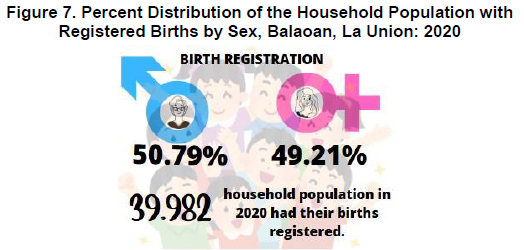
TECHNICAL NOTES
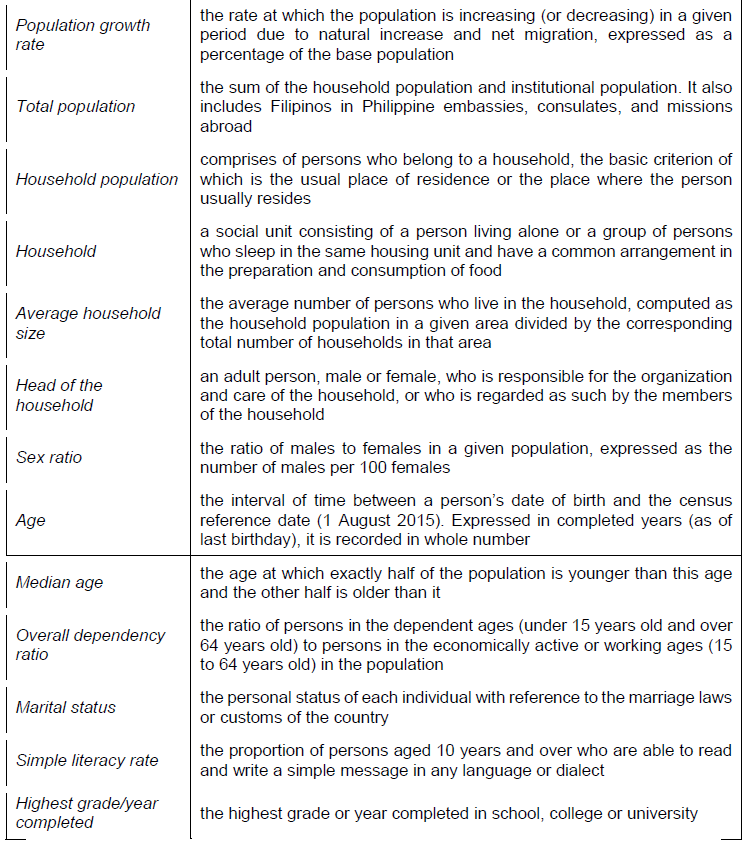
EXPLANATORY NOTES
The total population presented in this release is based on the 2020 CPH. The population count is declared official for all purposes by the President of the Philippines, pursuant to Proclamation No. 1179 dated 06 July 2021. The total population represents the total number of persons living as of 12:01 AM on 01 May 2020 in the country. It also includes Filipinos in Philippine embassies, consulates, and missions abroad.
SGD. DANITES E. TEÑIDO, PhD
Chief Statistical Specialist
KJGH/VALJ

